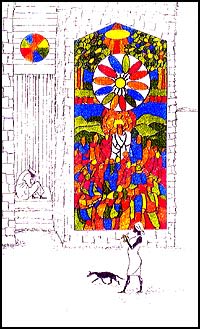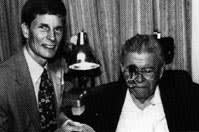FOCUS
ON LOW VISION
Patient Success
Stories
By Stephanie K. De Long
Low vision is debilitating. It robs people of their visual independence...and often of their dignity. Thanks to a combination of evaluation, assessment, technology, and training, there are more success stories every day�stories of dedicated doctors and determined patients working together to overcome disabilities. Following are just a few of the recollections of doctors and patients as told to Eyecare Business over the past couple of years.
Accomplished Artist
When Len Leone, the former art director of a major publishing house, lost all of his vision in one eye and most of it in the other, he thought his drawing and painting days were over. �It was a pretty depressing situation,� he told EB. But, after being introduced to an Optelec video magnifier through the Lighthouse in New York City, he began painting again. �My work has changed dramatically,� he said. �It�s realism, but it�s decorative realism. I use color a lot more efficiently.� His work shown on this page was, in fact, exhibited in a one-man show at the Society of Illustrators in New York.
Medical Merry-Go-Round
|
|
|
|
�Tobago
Church� by Len Leone, who suffers from low vision. |
|
Bill Takeshita, O.D., director of the Center for the Partially Sighted in Los Angeles, told EB about Christopher, who was born with congenital optic atrophy. Like many low vision patients, Christopher was taken to a myriad of doctors after his parents first noticed their toddler had vision problems. �We were on a medical merry-go-round,� his mother said. �We had spent $10,000. Then�one hour and $87 later�we had a diagnosis from Dr. Takeshita.�
As with all low vision patients, the youngster�s needs changed as his interests and schooling evolved. His active lifestyle also called for several types of aids. For example, the Center designed a pair of specialized bifocals so that he could read regular print.
For distance viewing like the blackboard in the classroom, he was prescribed glasses with a bioptic telescope on the top portion of the lens. �When he needs to see smaller details,� explains Takeshita, �he can tilt his head down and look through the telescope which will magnify images 4x. With this aid his visual acuity improves from 20/200 to 20/40.� And, for outdoor use, the doctor prescribed high contrast filters.
Light Sensitivity
In Ann Arbor, Mich., Steven Bennett, O.D., discussed another youngster�a 12-year-old named Maggie�who first came to his office with her head down and her hands over her eyes. Maggie�s grandmother explained that the family and her teachers could not get through to the young girl, who had a mild form of cerebral palsy.
Though the grandmother was skeptical, Bennett told EB, �I got the idea that there may have been a glare problem and placed her in a pair of Corning glare control lenses. We just watched her. All of a sudden, she opened her eyes. There was no tearing. She shot her head up, and she started looking around. It was pretty incredible.�
�I want to read�
A 78-year-old retired engineer who suffers from dry macular degeneration could no longer read comfortably and said he �was so frustrated I didn�t know where else to turn. I�d tried lots of things, but nothing was comfortable. And without being able to read, I felt really lost. Then a friend heard a radio ad for Vision Advantage.� The result of efforts between patient, vendor, and doctor was the patient�s purchase of a pair of Zeiss magnifying bifocals in +8 with convergence relieving prism. �I know there are so many people who don�t know there�s anything out there that will help,� said the former engineer, whose best-corrected vision is 20/80. �I got lucky.�
A Tisket, A Tasket
While a few require just one product for full-time use, most who suffer from low vision problems require multiple solutions for a variety of tasks. Eileen, a macular degeneration patient of the Deicke Center for Visual Rehabilitation in Wheaton, Ill., had a request that required several products...and a lot of ingenuity on the part of the staff. She told the counselor, �I want to be able to make sugar flowers. Making these flowers is my life, and I want my life back.�
For Eileen, the doctor prescribed +12 reading glasses, a magnifier attached to a lamp, and an electronic reading machine. The rehab teacher taught her the techniques necessary to use each device. The result? Using the CCTV, she was able to roll out the balls of dough and cut the shapes. Then, wearing the reading glasses and working at a distance of 3-1/2� she could once again shape the flowers.
Seeing Her Children
The mother of two young sons, Kathy was left with severe optic nerve damage after a bout of menengitis. She had no vision in one eye and a only a small temporal island left in the other. She�d had little success with devices until Ned Witkin, O.D., fit her with a head-mounted camera and display system by Enhanced Vision Systems that uses digital technology to capture, enlarge, and enhance images. The director of Vision Rehabilitation Services at Emory University Eye Center in Atlanta, Witkin reported that the vision in her one eye was enhanced to 20/50. The result? She was once again able to read, work on a Ph.D., and, more important, see her two boys. �It completely changed her life,� Witkin told EB.
Golf Again
|
|
|
|
Randy
Kinkade, O.D., helped his patient read again. |
Histoplasmosis had robbed an active, 48-year-old doctor of his vision. With best corrected vision of 20/200, he could no longer pursue either his vocation or avocation�that is, practice medicine or play golf. After a long string of referrals and no success with any of the low vision aids he tried, he was severly depressed. The fact that he is a doctor made his inability to find anything that helped even more frustrating. �Even my peers couldn�t come up with any solutions,� he recalled. Finally, he was evaluated with a video headset, and his life took a totally different turn. He could read again, and thanks to contrast enhancement in a virtual environment, he was able to start a new career as a consultant to an insurance company. Just as important to him, he even began playing golf again.
A Resourceful Approach
Sometimes, patients help create their own adaptive strategies. Two years ago, Randy Kinkade, O.D., shared his story with EB about an elderly macular degeneration patient he�d seen in his Litchfield, Conn. office for an evaluation. The patient, who was 10/140 OD and 5/350 OS, was specific in his request for an improvement to his current optical system.
�This resourceful gentleman had developed a clever approach to meet his magnification needs,� recalled Kinkade. Without wearing his spectacle correction, the patient had been using a 28D non-illuminated stand magnifier with the base held against his right orbital rim. This stabilized the device, held the lens 30mm from his eye, and allowed him to read .8M print at a distance to 15cm.
His request? That the doctor design a rubber band clip to attach the magnifier to his frame so that he wouldn�t have to hold the aid to read. By attaching a 28D Eschenbach monocular loupe to his spectacles, Kinkade reported the patient experienced an improved level of visual functioning and less fatigue. And, with the device fixed to his slightly astigmatic correction, his hands remained free to manipulate his reading material.
Whatever the patient�s goal, it�s clear that meeting the task specific needs of patients requires a combination of skill, training, patience, determination, and sometimes ingenuity. �There are no cookie cutter solutions in low vision,� says consultant Bill Croft, Jr. �Even when the profiles of two patients appear to be the same, what works for one may not work for the other. Today�s technology is great, but it needs to be adapted to each individual. That�s the frustration�and the joy�of low vision.� EB
If you have a question about low vision or need answers to a problem presented to you by a partially sighted patient, send your query to eyecarebizeditor@boucher1.com. We�ll try to answer it in the Ask the Doctor column in our annual Focus on Low Vision, an insert to the June issue of EB.





